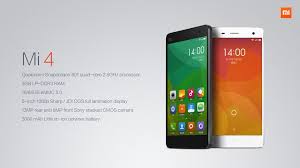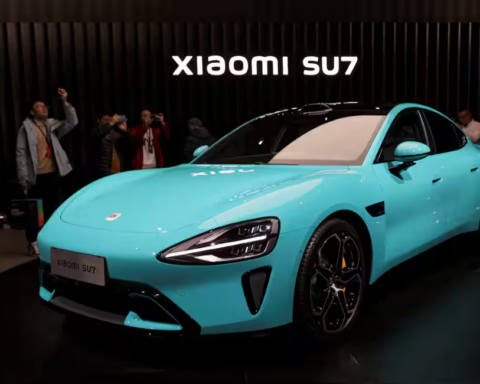Xiaomi debuted in India with the Mi 3, introducing the market to its  premium yet affordable smartphones. The demand outnumbered supply and for reasons only known to the company, it was discontinued a month after it went on sale in limited numbers.
premium yet affordable smartphones. The demand outnumbered supply and for reasons only known to the company, it was discontinued a month after it went on sale in limited numbers.
Six months and three budget smartphones later, Xiaomi is bringing its 2014 flagship, the Mi 4 to India. This time, it’s not the only one to offer value-for-money high-end smartphones. Also, the phone comes six months after its Chinese debut and is not a major upgrade when compared to the Mi 3.
Build & design
Unlike the Xiaomi Mi 3, which looks more tall and rectangular, the Mi 4 has rounded corners that give it a softer persona. You can’t help but notice the design’s similarity with the iPhone 5/5S, mainly due to its solid stainless steel frame and chamfered edges. The latter give the phone a very premium look, which is missing in devices such as the Huawei Honor 6 or Lenovo Vibe X2, that are priced similarly. The frame also makes the Mi 4 a solidly built device.
The front of the phone (in White colour) houses a 5-inch full-HD display. The capacitive touch navigation keys (backlit in white) are placed right below the display, backlit in white. The sensor array and the 8MP front camera sensor are placed above the display alongside the earpiece.
The volume rocker and power keys are made of metal and are located at the right edge while the sim card tray that houses a micro-sim is at the left edge. The buttons are responsive and offer decent tactile feedback.
The bottom edge houses the micro-USB port and a speaker grill while the 3.5mm headset jack and Infrared port sit at the top. There are two antenna bands on the top and bottom edges as well.
The back of the phone sports a slightly rounded plastic back cover with grating pattern design, which is essentially a diamond-style texture. The 13MP rear camera and LED flash are also placed at the back. The back looks slightly glossy and smudges easily though the smudges are not very visible unless you hold the phone under light.
To be honest, the plastic back doesn’t really go well with the phone’s premium design and metal frame.
Overall, the phone feels premium yet durable without any creaks and wobbles.
Display
Xiaomi Mi 4 sports a full-HD (1920x1080p)JDI/Sharp display that comes with Corning OGS (One Glass Solution) for protection against scratches. The display has high colour saturation so colours look more vivid and good to look at. However, colour rendering is not accurate which means that colours don’t look natural even when you set the screen saturation level to ‘Standard.’
The display offers wide viewing angles and is one of the brightest ones we’ve seen. The under-sun legibility was also good though the panel is slightly reflective. Touch response was excellent and made the phone more responsive.
Software
Xiaomi Mi 4 runs MIUI 6, a new version of the company’s operating system, based on Android 4.4 KitKat. The new OS boasts of a flatter design, smoother transition effects, better multitasking and notifications interfaces and gestures, among other features.
MIUI resembles Apple’s iOS in design and navigation and doesn’t come with a separate app drawer. It focuses on ease of use in addition to offering enhanced native apps, better notifications and things like call recording and call blocking.
One of the highlight features of MIUI is the ability to customize the user interface with themes, downloadable wallpapers and clocks. The Themes app offers a large number of free themes, each of which comes with a different set of icons, wallpapers, app switcher, font style, sounds, lock screen styles and even system apps. It’s worth pointing out that some MIUI themes don’t work with MIUI 6.
MIUI 6 allows users to identify, mark or block unwanted calls. It also supports batch organization of app icons and access to Notifications from any screen, including the lock screen (similar to iPhone). The new UI also offers floating notifications that show up at the top of the screen and are actionable. For instance, if you receive a phone call when you’re taking a picture via the camera app, it will display a floating prompt on top of the screen with end and accept buttons. It also has iOS-like badge notifications that show the unread count on top of app icons.
Unlike the Chinese version, the Indian version of the phone comes preloaded with Google Play Store and all Google apps including Maps, Gmail, YouTube and Hangouts.
The software does not include any stock Android app and everything including the Gallery, Music, Calculator, Calendar and Email apps are built by MIUI team. The apps look beautiful and offer additional value added features. Unlike MIUI 5, apps on MIUI 6 don’t have a lot of skeuomorphic design elements but some look eerily similar to iOS system apps (post iOS 7) complete with the colour scheme.
The MIUI app switcher can be launched by simply pressing the Menu key and now even offers app previews (you can pinch out to switch to app previews). It comes with the ability to free up memory by killing background tasks and clearing the cache. It even lets you lock certain background apps to exclude them from getting killed.
There are a number of additional features that MIUI offers compared to stock Android. For instance, the phone app features the ability to block calls and messages from select numbers. It also offers a built-in call recording feature that allows you to record calls for all numbers or select ones, depending on settings.
The Messaging app lets you pin important messages on top and hide messages from select contacts in a private messages folder which is smartly hidden in the inbox.
Widget mode for Notes and Music that enabled access to the functions without opening the apps have been removed.
The software has built-in security features including a virus scan and permission manager for apps. You can choose to get data usage notifications and see the network speed at the status bar. You can even choose if you want a particular app to work and connect only when you’re connected to the internet via Wi-Fi (or only on 3G.)
Mi Cloud lets you access your photos,contacts, messages, call logs and more from anywhere. With 10 GB of free storage and more powerful features, Mi Cloud seamlessly syncs all content on your Mi Phone, Mi Pad, Mi TV and more.
Overall, MIUI 6 looks more refined than its predecessor but some apps including the Camera and Music apps have been made more unintuitive. For some reason, the Music player did not show album art for music we downloaded from iTunes and Google Play.
The Settings menu (also iOS-inspired) doesn’t feature ‘Quick Settings’ for commonly used features and hides some critical settings under ‘More.’
Camera
The Xiaomi Mi 4 sports an 8MP front camera and a 13MP Sony stacked CMOS camera.
The Camera app has been totally revamped and doesn’t feature basic and advanced modes. Instead, there are three screens when you slide horizontally (in Still mode) – the first one featuring live filters, the middle one is the default camera interface and the last one has toggles for Burst, Panorama, HDR, Manual and Refocus modes and a settings button. In video mode the interface is limited to two screens with one offering toggles for fast and slow motion video and HDR in addition to Settings that even lets you select 4K video recording mode.







